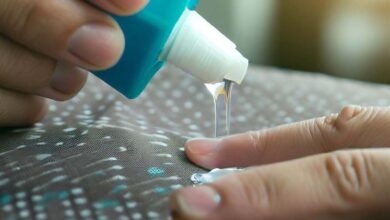Can You Put Fabric Softener in the Bleach Dispenser?

Fabric softeners and bleach are both common laundry additives that can enhance the quality and freshness of our clothes. While most of us are familiar with adding fabric softener to a designated compartment in our washing machine, we may wonder if it is possible to do the same with bleach. Specifically, can you put fabric softener in the bleach dispenser?
The bleach dispenser is not designed for fabric softener. It is essential to follow the manufacturer’s instructions for proper use. Using fabric softener in the bleach dispenser can create a clog or damage the dispenser. It is best to add fabric softener manually during the rinse cycle, as directed by the detergent manufacturer.
However, this article will explore the practicality and possible risks associated with putting fabric softeners in the bleach dispenser, providing valuable insights for those seeking optimal laundry care.
What Is A Bleach Dispenser?
A bleach dispenser is a compartment in a washing machine that holds and releases bleach during the laundry cycle. It ensures proper dilution and distribution of bleach, preventing direct contact with clothes, and reducing fabric damage or discoloration. Follow the manufacturer’s instructions for safe use, as improper handling can be harmful.
What Is The Purpose Of A Fabric Softener?

Fabric softener is a laundry product designed to make clothing, towels, and other fabrics feel softer and reduce static cling. It is typically used during the washing machine’s rinse cycle or added manually to the designated fabric softener dispenser.
Here’s what you need to know about fabric softeners:
- The primary purpose of fabric softener is to soften fabrics by coating the fibers with a thin layer of lubricating chemicals. This coating reduces the friction between the fibers, resulting in softer and smoother fabrics.
- Fabric softeners also help to reduce static electricity buildup in synthetic fibers, such as polyester and nylon. This reduces static cling, preventing clothes from sticking together or clinging to your body.
- In addition to softening and reducing static cling, fabric softeners can add a pleasant fragrance to your laundry. Many fabric softeners come in various scents, allowing you to choose a fragrance that suits your preference.
A bleach dispenser and fabric softener serve different purposes in the laundry room. While a bleach dispenser ensures safe and effective bleach distribution during the wash cycle, fabric softener helps to soften fabrics and reduce static cling. Understanding the role of each product can help you optimize your laundry routine and keep your clothes looking and feeling their best.
Can You Put Fabric Softener In The Bleach Dispenser?
In most cases, it is not recommended to put fabric softener in the bleach dispenser.
The bleach dispenser is explicitly designed for bleach, a powerful chemical to whiten and disinfect clothes. Fabric softeners, on the other hand, are meant to reduce static, soften fabrics, and add a pleasant scent. Mixing fabric softener with bleach could have potential risks.
Potential Risks Of Putting Fabric Softener In The Bleach Dispenser
Putting fabric softener in the bleach dispenser may seem convenient, but it can have potential risks. Like:
- Chemical reactions and damage to fabrics: Fabric softeners and bleach contain different chemicals; when mixed, they can potentially react and cause damage to fabrics. This can lead to discoloration, fading, or even deterioration of the fabric.
- Negative impact on cleaning effectiveness: Fabric softeners typically contain oils and waxes that can leave residue on clothing. When placed in the bleach dispenser, these residues can mix with the bleach, reducing its cleaning effectiveness. This can result in less effective stain removal and overall cleaning.
Additional Tips For Safe Usage Of Fabric Softener
To ensure proper and safe usage of fabric softener, it’s best to follow the recommended steps for your washing machine:
- Check the washing machine’s user manual: The manual should clearly state whether fabric softener can be added to a specific compartment or during a particular stage of the wash cycle.
- Use the designated fabric softener compartment: Most washing machines have a separate compartment designed explicitly for fabric softener. It is usually marked with a fabric softener icon. If your machine has this compartment, use it according to the instructions.
- Use the appropriate cycle: Some washing machines have specific cycles that automatically release the fabric softener at the right time during the wash cycle. If your machine has this feature, make sure to use the appropriate cycle for using fabric softener. And must follow the fabric softener expiration date. You may think, does fabric softener expire? Click here to read and get clarify the answer.
If your washing machine doesn’t have a fabric softener compartment or a specific cycle, you can manually add the fabric softener during the rinse cycle. Many people prefer to dilute the fabric softener with water before adding it to the load, as undiluted softeners can sometimes cause stains on clothes.
Again, it’s crucial to read and follow the instructions provided by the washing machine manufacturer to ensure proper usage and avoid any potential issues. If you have any doubts or concerns, consider consulting the manufacturer’s customer support or a laundry expert for guidance.
What Happens If You Accidentally Put Fabric Softener In The Bleach Dispenser?

We’ve all been there – rushing through our laundry routine and accidentally pouring fabric softener into the bleach dispenser. It’s an innocent mistake, but what consequences does it have?
Let’s explore what happens when fabric softener enters the bleach dispenser and how it affects your laundry.
Chemical reaction:
When fabric softener is placed in the bleach dispenser, it can react with any bleach residue left behind, potentially causing a chemical reaction.
Undiluted softener:
The bleach dispenser is not designed to handle undiluted fabric softeners. Unlike bleach, fabric softener is typically added during the rinse cycle, where it’s diluted with water. Pouring it directly into the bleach dispenser can lead to undiluted softener entering the wash cycle.
Residue build-up:
Fabric softeners can also leave a sticky residue inside the bleach dispenser over time. This residue can accumulate and clog the dispenser, affecting its functionality and preventing proper bleach dispensing in future washes.
Stained clothes:
One of the most immediate consequences of pouring fabric softener into the bleach dispenser is the potential for staining clothes. Fabric softener isn’t designed to be used as a bleach substitute and may discolor or stain certain fabrics.
Reduced bleaching effectiveness:
Lastly, when fabric softener mixes with bleach, it can diminish its effectiveness. This can result in less effective stain removal or whitening of clothes, as fabric softeners often contain ingredients that counter the bleaching power.
Considering these key points, it’s clear that the accidental pouring of fabric softener into the bleach dispenser is not ideal. Always double-check your laundry products and their proper usage to prevent such mishaps.
Can Fabric Softener Damage The Bleach Dispenser?
Using fabric softener in the bleach dispenser can potentially cause damage to the dispenser and other parts of your washing machine. Here are some key points to consider:
- Fabric softeners are typically thicker in consistency compared to bleach, which may lead to clogs or blockages in the bleach dispenser’s narrow tubes or channels.
- The ingredients in fabric softeners can sometimes react with residues left behind by bleach, resulting in buildup or even damage to the dispenser over time.
- The bleach dispenser is explicitly designed for bleach, and introducing fabric softener into it may interfere with the proper functioning of the dispenser.
To avoid any potential damage, using the fabric softener dispenser or adding the fabric softener directly to the rinse cycle during your laundry routine is recommended. This ensures that the fabric softener mixes evenly with the water and clothes without causing any harm to the bleach dispenser.
How To Add Fabric Softener Without Dispenser: Smart Laundry Hacks
If you own a washing machine without a built-in fabric softener dispenser, don’t worry; there’s a simple solution to add fabric softener effectively.
Firstly, ensure your washing machine has completed the wash cycle and is ready for the rinse cycle. Dilute the fabric softener with water in a separate container, maintaining a 50/50 ratio. Once diluted, pour the mixture slowly into the washing machine’s rinse cycle compartment. This technique ensures proper dispersion of the fabric softener, leaving your clothes soft and fresh.
For a visual guide, I recommend checking out the video “How to Add Fabric Softener Without a Built in Dispenser in Washing Machine?” It provides practical tips for achieving soft, fragrant laundry without the dispenser hassle.
Conclusion
Finally, it says, can you put fabric softener in the bleach dispenser? It is not recommended to put fabric softener in the bleach dispenser. While some individuals may find combining these two laundry products convenient, it can lead to several issues. Fabric softeners and bleach have different chemical compositions that may not interact well.
This can reduce the effectiveness of both products and potentially damage your laundry. Additionally, fabric softeners often contain oils and other ingredients that can clog the dispenser, leading to further problems in the washing machine. It is best to follow the manufacturer’s instructions and use the designated compartments for each product.
This ensures your laundry is cleaned correctly and conditioned without any unwanted side effects. Taking these precautions will help prolong the life of your washing machine and provide you with clean, fresh-smelling clothes. Always read the labels and follow the recommended usage guidelines to achieve the best results.
You can also read:



